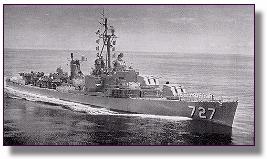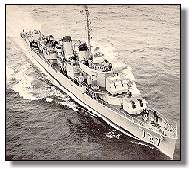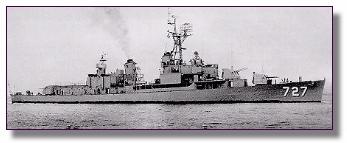History
[ Detailed History ] [ First DeHaven ] [ World War II ] [ Korea ] [ Desron 9 History ] [ Operation Hardtack - 1 ] [ DeHaven Unit Awards ] [ Vietnam Era ]
 The United States Ship DeHaven (DD-727) was commissioned in
March 1944 as the second destroyer to bear the name of Lieutenant Commander E. J. DeHaven, an early arctic
explorer. The first DeHaven (DD-469) was
destroyed and sunk as a result of enemy action in 1943. The present DeHaven
also saw action in World War II in operations at Leyte Gulf
, Iwo Jima, and
Okinawa. The United States Ship DeHaven (DD-727) was commissioned in
March 1944 as the second destroyer to bear the name of Lieutenant Commander E. J. DeHaven, an early arctic
explorer. The first DeHaven (DD-469) was
destroyed and sunk as a result of enemy action in 1943. The present DeHaven
also saw action in World War II in operations at Leyte Gulf
, Iwo Jima, and
Okinawa.
 DeHaven was on station in the Far East when South Korea was
invaded in 1950. She assisted in the evacuation of American Nationals from
Inchon on the second day of the war. Her crew received the honored Navy Unit
Commendation Medal for action in Inchon in support of amphibious operations.
Throughout the Korean War the ship completed four combat tours and participated
in carrier operations, amphibious support, coastal blockade, and naval gunfire
support of troops at the front. Read about one such operation and the commendation the
DeHaven received. DeHaven was on station in the Far East when South Korea was
invaded in 1950. She assisted in the evacuation of American Nationals from
Inchon on the second day of the war. Her crew received the honored Navy Unit
Commendation Medal for action in Inchon in support of amphibious operations.
Throughout the Korean War the ship completed four combat tours and participated
in carrier operations, amphibious support, coastal blockade, and naval gunfire
support of troops at the front. Read about one such operation and the commendation the
DeHaven received.
Since the Korean conflict, DeHaven continued to play an active role
in Pacific Fleet operations. She participated in Operation Hardtack I, the nuclear detonations
in the south pacific during the summer of 1958. Her mission specific duties can
be found here.
She was awarded the Armed Forces Expeditionary Medal for operations in the
Que mon-Matsu area, the Taiwan Straits and Vietnam. DeHaven participated in
carrier task group operations and performed radar picket and surveillance
tracking assignments throughout the Western Pacific. During the Vietnam crisis,
DeHaven served as a Naval Gunfire Support Unit in I, II, III, IV Corps and Rung
Saat Special areas. She served as a Search and Rescue Unit on North SAR
Station, on Sea Dragon operations off the coast of North Vietnam, and as rescue
destroyer on attack carrier operations. During this time DeHaven fired over
22,000 naval gunfire rounds in support of friendly troops and in North Vietnam.
The ship also participated in the rescue of four pilots downed off the coast of
North Vietnam.
 As part of Destroyer
Squadron 9, DeHaven was awarded the
Navy Unit Commendation for her service. As part of Destroyer
Squadron 9, DeHaven was awarded the
Navy Unit Commendation for her service.
A Sumner-class destroyer, DeHaven had a displacement of 2670 tons, a
length Of 376'6" and a beam of 40'6". She went through the Fleet
Rehabilitation and Modernization Program (FRAM) in 1960, resulting in a greatly
increased anti- submarine ability. In addition to her main battery of six
5"/ 38 guns, she carried eight ASW torpedo tubes, and two Drone
Anti-Submarine Helicopters (DASH). She could steam 8,000 miles without
refueling and, with a total horsepower of 60,000, was capable of a maximum
speed of 33 knots.
DeHaven was decommissioned and turned over to the Korean Government in and
christened ROKN Inchon DD-98 in December of 1973. See a
photo of the final DeHaven deck log.
|